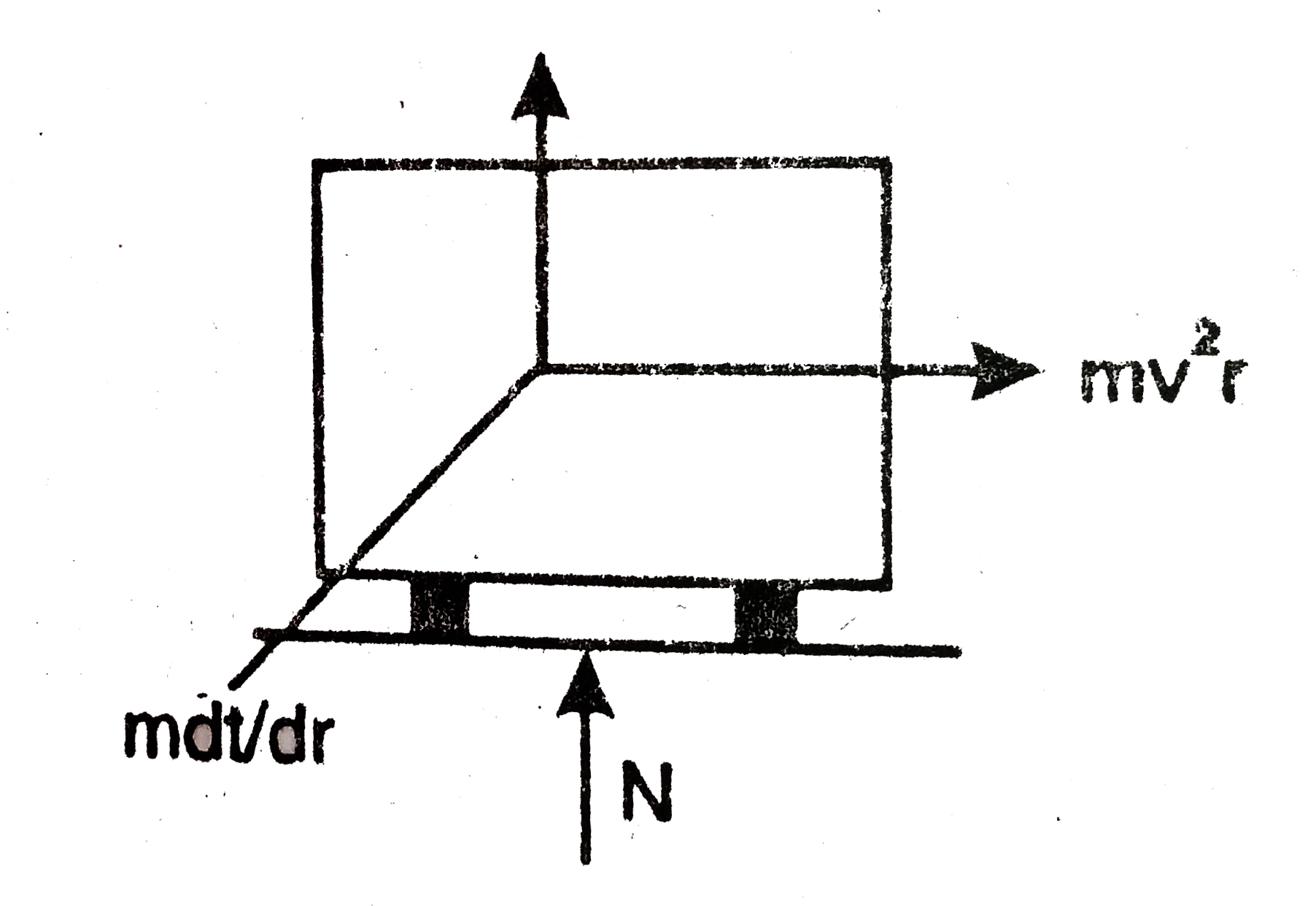A car starts rest, on a horizontal circular road of radius R, the tangential acceleration of the car is a. The friction coefficient between the road and the tyre is μ Find the speed at which car will skid and also find the distance after travelling it skids.Solution in Tamil
The correct Answer is:A, B, D
Since the motion is non uniform, the acceleration has both radial and tangential components.
a=v2r
at=dvdt=a
Resultnt magnitude = √(v2r)2+a2
Now,mN=m√(v2r)2+a2
→μmg=m√(v2r)2+a2
→μ2g2=v4r2+a2

→v4r2=(μ2g2−a2)
→v4=(μ2g2−a2)r2
→v=[(m2g2−a2)r2])14)
Topper's Solved these Questions
- BOOK - HC VERMACHAPTER - CIRCULAR MOTIONEXERCISE - Objective -27videos
CIRCULAR MOTION
- BOOK - HC VERMACHAPTER - CENTRE OF MASS, LINEAR MOMENTUM, COLLISIONEXERCISE - Exercises64videos
CENTRE OF MASS, LINEAR MOMENTUM, COLLISION
- BOOK - HC VERMACHAPTER - FLUID MECHANICSEXERCISE - All Questions96videos
FLUID MECHANICS
Similar Questions
An object follows a curved path. The following quantities may remain constant during the motion
01:30View SolutionThree particles of masses 1.0 kg 2.0 kg and 3.0 kg are placed at the corners A,B and C respectively of an equilateral triangle ABC of edge 1m. Locate the centre of mass of the system.
03:04View SolutionWater is filled in a flask up to a height of 20 cm. The bottom of the flask is circular with radius 10 cm. If the atmospheric pressure is 1.01×105 Pa, find the force exerted by the water on the bottom. Take g=10ms−2 and density of water =1000 kgm^-3.
04:00View SolutionA car is travelling along a curved road of radius r. If the coefficient of friction between the tyres and the road is mu the car will skid if its speed exceeds .
05:32View SolutionThe maximum speed that can be achieved without skidding by a car on a circular unbanked road of radius R and coefficient of static friction μ , is
05:00View SolutionFind the maximum velocity for skidding for a car moved on a circular track of radius 100 m . The coefficient of friction between the road and tyre is 0.2
07:48View SolutionA car starts from rest in a circular flat road of radius R with an acceleration a. The friction coefficient between the road and the tyred is μ Find the distance car will travel before is start skidding.
03:51View Solutionएक कार एक क्षैतिज वृत्ताकार सड़क पर चल रही है जिसकी त्रिज्या R है। इसकी चाल एकसमान दर dv/dt =a से बढ़ रही है। टायर तथा सड़क के बीच घर्षण गुणांक μ है। कितनी चाल पर यह कार सड़क पर फिसलने लगेगी ?
03:18View SolutionA car starts from rest on a horizontal circular road of radius 190 m and gains speed at a uniform rate 1*2 m//s^(2) . The coefficient of static between the road and the tyres is 0*37 . Calculate the distance travelled by the car before it begins to skid.
02:34View SolutionFind the maximum speed with which a car can turn on a bend without skidding, if radius of bend is 20 m and coefficient of friction between the road and the tyres is 0.4.
02:28View SolutionThe maximum speed that can be attained by a car, without skidding, on a horizontal circular road of radius R and coefficient of kinetic friction μ is
02:26View SolutionA car is moving along a straight horizontal road with a speed V_0 If the coefficient of friction between the tyres and the road is mu , the shortest distance in which the car can be stopped is :
02:54View SolutionA car has to move on a level turn of radius 45 m. If the coefficient of static friction between the tyre and the road is μs=2.0, find the maximum speed the car can take without skidding.
05:24View SolutionA car goes on a horizontal circular road of radius R. The speed of car is increasing at constant rate a m/s2. If the friction coefficient between the road and the tyre is μ, then the limiting speed of car is
04:09View SolutionThe maximum speed that can be achieved without skidding by a car on a circular unbanked road of radius R and coefficient of static friction p is
02:02View SolutionThe maximum speed that can be attained by a car, without skidding, on a horizontal circular road of radius R and coefficient of kinetic friction μ is
03:26View Solution

